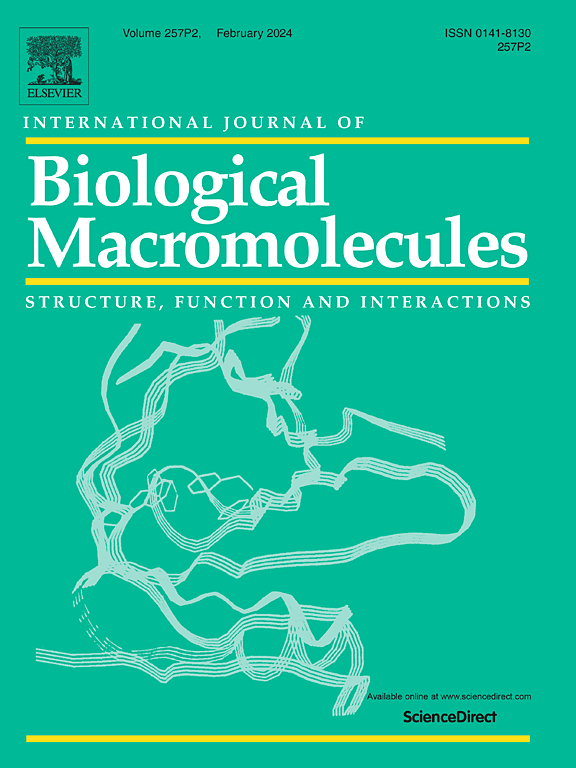Engineering homoserine kinase for competitive inhibition release to enhance l-threonine production in Corynebacterium glutamicum
IF 8.5
1区 化学
Q1 BIOCHEMISTRY & MOLECULAR BIOLOGY
International Journal of Biological Macromolecules
Pub Date : 2025-08-05
DOI:10.1016/j.ijbiomac.2025.146536
引用次数: 0
Abstract
l-threonine is widely used in the food, pharmaceutical, cosmetic, and feed industries. However, the activity of homoserine kinase (HK) in Corynebacterium glutamicum is competitively inhibited by l-threonine, restricting the efficient production of l-threonine. To address this inhibition, we identified a critical residue Arg212 and subsequently generated an optimal mutant R212Q via site-directed saturation mutagenesis. Kinetic characterization revealed that the HKR212Q variant exhibited both enhanced binding affinity for l-homoserine and a 2-fold improvement in catalytic efficiency. Molecular docking simulations demonstrated that the mutated substrate-binding pocket sterically hindered l-threonine binding while accommodating l-homoserine. Further mechanistic insights were obtained through molecular dynamics simulations, which uncovered ligand selectivity determinants mediated by dynamic flexibility changes in three functional regions. Finally, we achieved 86.4 g/L of l-threonine with a yield of 0.28 g/g glucose by overexpressing the efflux transporter ThrE in the engineered strain R212Q/pXTuf-thrE, representing the highest l-threonine production to date. The Arg212 residue identified in this study represents the first characterized site capable of relieving competitive inhibition in HK family. The mechanistic elucidation provides valuable insights for engineering other kinase-family proteins to overcome similar metabolic constraints.
工程同源丝氨酸激酶竞争性抑制释放促进谷氨酸棒状杆菌l-苏氨酸生产
l-苏氨酸广泛应用于食品、制药、化妆品和饲料行业。然而,谷氨酸棒状杆菌的同型丝氨酸激酶(HK)活性受到l-苏氨酸的竞争性抑制,限制了l-苏氨酸的高效生产。为了解决这种抑制,我们确定了一个关键残基Arg212,随后通过定点饱和诱变产生了一个最佳突变体R212Q。动力学表征表明,HKR212Q变体对l-高丝氨酸的结合亲和力增强,催化效率提高了2倍。分子对接模拟表明,突变的底物结合口袋在容纳l-同型丝氨酸的同时,在空间上阻碍了l-苏氨酸的结合。通过分子动力学模拟获得了进一步的机制见解,揭示了配体选择性决定因素是由三个功能区的动态柔韧性变化介导的。最后,我们通过在工程菌株R212Q/pXTuf-thrE中过表达外排转运体ThrE,获得了86.4 g/L的L -苏氨酸,产量为0.28 g/g葡萄糖,这是迄今为止最高的L -苏氨酸产量。本研究中鉴定的Arg212残基是HK家族中第一个能够缓解竞争抑制的特征位点。机制的阐明为工程其他激酶家族蛋白克服类似的代谢限制提供了有价值的见解。
本文章由计算机程序翻译,如有差异,请以英文原文为准。
求助全文
约1分钟内获得全文
求助全文
来源期刊
CiteScore
13.70
自引率
9.80%
发文量
2728
审稿时长
64 days
期刊介绍:
The International Journal of Biological Macromolecules is a well-established international journal dedicated to research on the chemical and biological aspects of natural macromolecules. Focusing on proteins, macromolecular carbohydrates, glycoproteins, proteoglycans, lignins, biological poly-acids, and nucleic acids, the journal presents the latest findings in molecular structure, properties, biological activities, interactions, modifications, and functional properties. Papers must offer new and novel insights, encompassing related model systems, structural conformational studies, theoretical developments, and analytical techniques. Each paper is required to primarily focus on at least one named biological macromolecule, reflected in the title, abstract, and text.

 求助内容:
求助内容: 应助结果提醒方式:
应助结果提醒方式:


